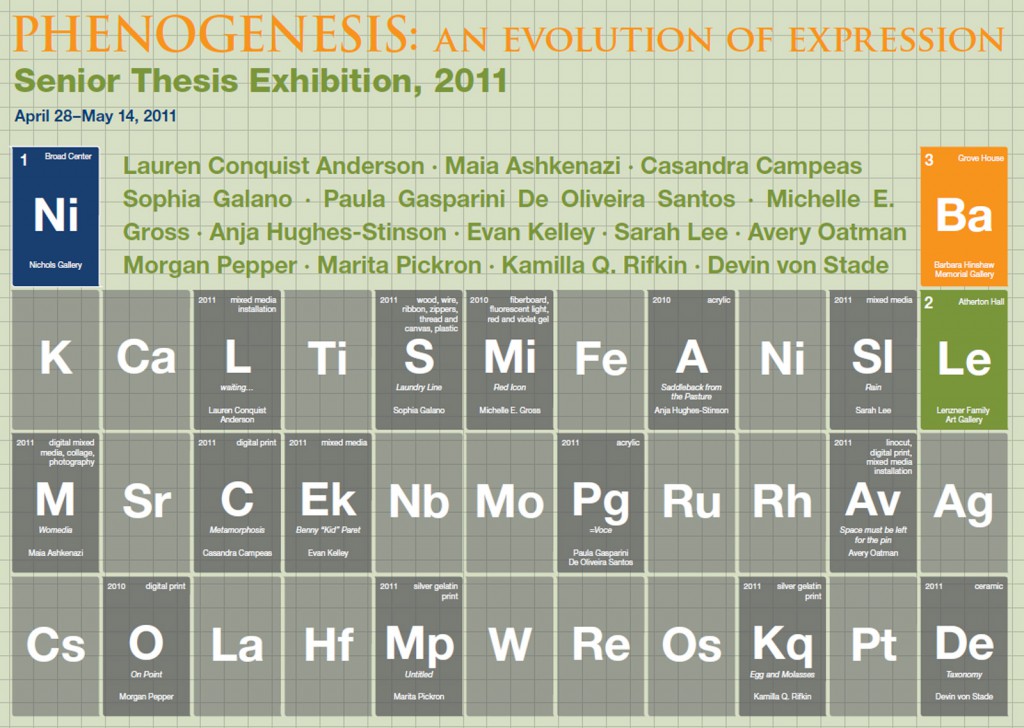
phenogenesis: Senior Art Exhibition 2011
phenogenesis: an evolution of expression
April 28-May 14, 2011
Nichols Gallery, Lenzner Family Art Gallery, Barbara Hinshaw Memorial Gallery
Lauren Conquist Anderson • Maia Ashkenazi • Casandra Campeas • Sophia Galano • Paula Gasparini De Oliveira Santos • Michelle E. Gross • Anja Hughes-Stinson • Evan Kelley • Sarah Lee • Avery Oatman • Morgan Pepper • Marita Pickron • Kamilla Q. Rifkin • Devin von Stade
Lauren Conquist Anderson
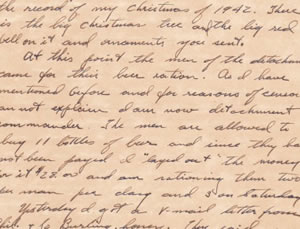
I find beauty in simple things: in magic and forts and confetti on a bad day; in children, and face paint, typography, and geography; in memories and mistakes. I collect images, scraps, and found objects from my daily life and incorporate them into my work as a reminder of a moment, a specific place, a collection of happenings. As my life has evolved, so too has my art. When I begin an artwork I am never exactly sure how it will end up. It is a process with unknowns and uncertainties, made up of mistakes and corrections. My work represents my journey: it is about the places and people who have touched me, where I have been, what I have gone through, and who I am because of it. I incorporate the scraps of life because I believe that trash can be treasure, that ambience can be art. I believe in creating work as a way to express yourself and share a part of who you are. I believe in using art as a way to cope with a sadness I do not always understand. This particular piece is about waiting. It’s about the not knowing, the loneliness and the pain, the uncertainty, the fear, and the hoping and dreaming of what is to come. Both of my grandmothers married my grandfathers before they deployed overseas for World War II. They waited four years for them to come home. And then I waited. [clear]
Maia Ashkenazi
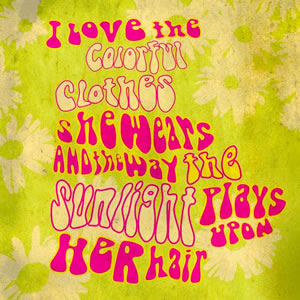
My work blurs the boundaries between form and function. To me, art and design are often indistinguishable, for both deal with composing something beautiful for a purpose, whether the purpose is aesthetic enjoyment, value, utility or conveying a concept or message. My artistic practice is currently wide-ranging, but my goal in the next few years is to narrow my focus. My previous work ranges from artist books and coffee table books, photography, colorful patterns, merchandise and advertising collateral, to found-object jewelry, mixed-media and digital collage, printmaking, painting and drawing. Common themes throughout my work are bright color harmonies, juxtaposition of detail with simplicity and contrast in value, shape and scale. My work shown in Phenogenesis is a series called “Womedia.” It consists of six cover artworks, one piece for each decade from the 1950s until today. Each piece in the series includes a few lines of lyrics from a song from that decade that address how women are represented or stereotyped within that decade. Each piece is displayed on the appropriate audio playback format for its decade. The aesthetic elements used within each piece draw from the visual style of each decade, yet the viewer should note the irony that these pieces were created today in order to look “vintage.” “Womedia” deals with women’s stereotyping issues in the media as well as misogyny in song lyrics in popular music within the entertainment and music industries. [clear]
Casandra Campeas
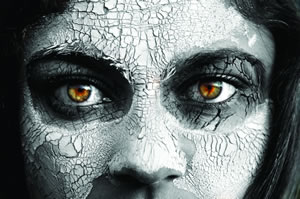
As a child, I knew photography was something I would love from the moment I picked up my mom’s camera. It didn’t become a passion until high school. My work stems from the interactions I have with my subjects and from my love for texture and detail. Like people, I believe ideas evolve into something unexpected. I enjoy creating an environment that is both a personal and comfortable space for the subject. I am drawn to small objects and enjoy exploring how light and color can add a transitional quality to black and white photography. Through digital photography, make-up and costuming, I examine the varied emotions that occur during a transitional period. I want to experiment with color while retaining the drama a black and white image has to offer. As time moves forward, the body evolves and inevitably deteriorates, through natural or unnatural causes. I picture this deterioration as a disease in itself, similar to the shedding of the skin. My goal is to express a kind of growth and decay through multiple textures and contrast. I want this decay, in part, to represent a resistance to evolution, a refusal to accept that time moves forward regardless of whether we are prepared. Each individual processes change in his or her own way. I believe accepting life changing events contributes to an evolution of the self. Change is inevitable and resistance towards it prevents the individual from moving forward and learning from past experiences. Some individuals focus on the excitement and embrace the journey. As I begin the next chapter of my life, I am joyful yet know it will be a struggle to let go of the past. [clear]
Paula Gasparini De Oliveira Santos (GDOS)
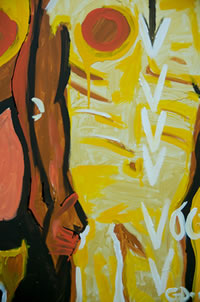
Letting Go.
(To Release, Relinquish, Unclasp, Withdraw, Unleash, To Bring Out)
To let go is to surrender and to give in to the forces beyond your control—surrendering does not mean to abandon or run away from what comes our way, but rather to immerse ourselves in everything without restraint. My work is the expression of how I live; it is effortless, though I do not mean easy, but rather without pain. I create images without regret or restraint and continually I paint over them. I value my paintings, but value the act of creation itself as paramount. Because life is transient, I let go of the permanence of images and instead recognize that it is the process of expression that remains with me eternally. My creations are free in form but are directed by an inner order and discipline—that of intuitive feeling. I drown my emotions in paint and words, so that I can free them. I let go in order to understand. My art is my self-expression—the symbols are personal but I share them and by doing so hope to inspire expression in others. I believe in the power of communication and unity, and the endless possibilities that can come from it. We were all born with the luxury of finding ourselves; I believe the power of expression is in all of us, children all over the world are proof. [clear]
Sophia Galano
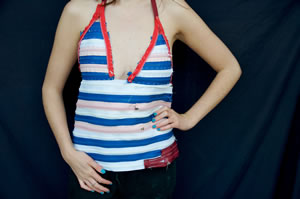
My senior thesis comprises three components using mixed media, wearable sculpture, fiber art and painting. The works are produced with unconventional materials and are constructed using traditionally “feminine” crafts such as knitting and sewing. Both the zipper and gown pieces are sewn by hand and machine, and are designed to fit my own body. The wire corset is knit on two different sized wooden needles, and can be adjusted by the back ribbons. These three works seek to question conventional ideas about femininity, domesticity, gender and sexuality. I am deeply influenced by artists exploring similar issues, such as Judy Chicago, Sharon Kagan, Annette Messager, Liza Lou and Cindy Sherman. My work also references historical symbols, such as the corset and formal gown. The zipper-halter-top strives to present a contemporary symbol of gender and sexuality. My artwork conceptualizes these issues through medium choice, subject matter and material. These works are not intended to fully reflect fashion or design, but instead meditate on aspects of gender and what it entails to be a woman. I did, however, choose the routine of dress and wearability as a means to contribute to the subject of gender. Throughout my career at Pitzer College I have attempted to explore this theme, and answer questions pertaining to gender for a young woman such as myself. These three pieces represent what I have learned in classes as well as in my everyday life. [clear]
Michelle E. Gross
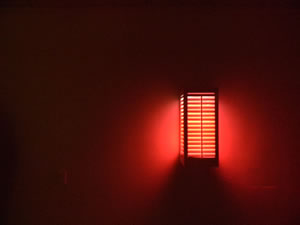
The works featured in the exhibition bring together and expose two of my obsessions within an aesthetic dichotomy: decrepit objects and light. I have been deeply inspired by the work of the Minimalist artists, Dan Flavin in particular. Flavin’s candid and innovative use of fluorescent lights challenged the formally dominant concept of a fine art medium. I admire other artists, such as Marcel Duchamp and Robert Rauschenberg, who likewise proved that even the detritus of modern existence could be art. Stylistically, my work shifts from the highly colorful and playful to work that is raw and unrefined. What excites me about used and found objects is that they are infused with an innate sense of nostalgia and history. Removing these objects from their utilitarian past and recontextualizing them into my pieces opens new lines of dialogue about function, design and art. I wanted to create an environment that evokes a different kind of perceptual experience from the one we encounter every day. The gallery space generated by my work is one where light, movement and perception combine to create a sensory experience that is enveloping and aesthetically perverse. I aspired to create a space enveloped in glow, where the interplay of light and our perception were as equally important as the objects themselves. [clear]
Anja Hughes-Stinson
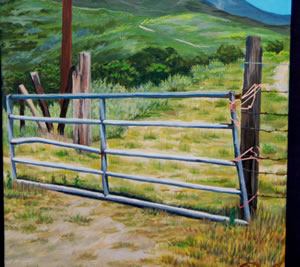
My horse’s hooves crushing the grass with every step and the wind whipping through the dead twigs are the only sounds as we traverse a ridgeline trail high above the city. There is a feeling of peaceful, beautiful loneliness, a welcome isolation, when you simultaneously feel above it all, and yet startlingly insignificant and invisible. My passion for horseback riding, exploring and being in nature provides the unique genesis for my work. The inspiration for this body of work springs from long rides into the “wilderness.” I use this term loosely because there are very few truly wild places left, especially in this sprawling suburban area. This is a profound tragedy and something worth considering, documenting and discussing. My goal is to take the viewer with me on a journey to some of my favorite “wild” places; places which have deep meaning and fond memories. My paintings strive to capture these often unseen landscapes, allowing the viewer a glimpse of places they may never have an opportunity to explore for themselves. In addition, my work investigates mankind’s impact on nature by exploring the interaction between man-made objects, nature, and time. Nature slowly deconstructs human artifacts and reincorporates them into the natural landscape. I attempt to capture this phenomenon of the natural decay of these now abandoned, but once useful things, as well as the ephemeral feelings I experienced at the initial discovery of these lonely objects and forgotten places. [clear]
Evan Kelley

The last two years have seen a large amount of my work focusing on the cultural history of boxing: one of mankind’s oldest yet most vilified sports. The drama of such one-on-one combat is inherent. With the competition exclusively between two individuals, and the brute (or as some would prefer, archaic) skills which value is placed on, issues of race, nationality, religion and even political association have long been brought to the front of discourse, with the boxing match as the vehicle. Throughout its history, boxing has also come under immense scrutiny due to its danger and violence as a form of media entertainment. It is not difficult to locate broadcasted video of a fight in which a fighter dies or is irreparably harmed due to damage in the ring. Some argue that this fact is proof that boxing does not deserve to be deemed a sport and should be made illegal. Defenders of the sport argue that one only need look as far as the news to see far worse violence in equally or even more grandiose depictions. Furthermore, these people argue that boxing provides an opportunity for upward mobility among the dispossessed, who are often victims themselves of predatory managers and promoters. My work for this exhibition investigates the love/hate relationships and seemingly paradoxical views boxing falls under for a media-obsessed, particularly violent-media-obsessed, American society. [clear]
Sarah Lee
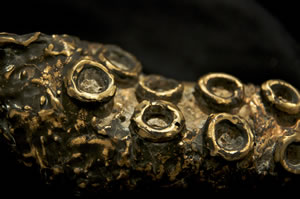
I employ mundane materials that have limited use or are doomed to end up in a landfill and transform them into an artwork that represents the majesty of our natural world. The dichotomy created using discarded materials to represent the purity of nature sparks a conflict of mind for the viewer. I enjoy manipulating material to resemble something of nature without being an exact replica of it. Our creations can never reach the intricate and complex level of nature, but through artistic representation the viewer is encouraged to question the affect of human intervention in this world, especially regarding the changing biosphere and fauna around us. I am greatly influenced by water and the elements of our natural environment. The natural world is extraordinary in its transformative capacity. I believe we have only scraped the surface of astounding life in the ocean and on land and have much more to discover. My work is a commentary on how much influence we have on life we do not even know exists. My work also asks questions and produces wonderment about what we do not know or understand. [clear]
Avery Oatman
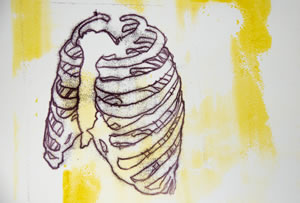
My work explores the paradox between the carefully crafted artwork and one that highlights improvisation and the unconscious. I am inspired by color, texture, energy and rhythm. As a dancer and artist, I work to fuse movement, complex compositional patterns, and an awareness of the body’s anatomical structures into my mixed media work. My passion for art grew out of a yearning to find treasure in odd places and the desire to explore relationships between symbols and their meanings. Linked to themes explored by the readymade and found art, I think art has the capability to distort, comment, recreate, elude, add, deconstruct, and demystify the obscurities and beauty of everyday objects. Inspired by Ferdinand Saussure’s theories on socio-linguistics and the arbitrary nature of words, I experiment with controversial systems of structure and varying modes of analysis and representation. Whether it be combining a digital image with an intaglio print, or working on wood, metal or paper, I am constantly surprised by the versatile and malleable nature of the medium employed in my work. I understand art, not only as a form of individual expression, but as a catalyst for social change that should be made accessible to a range of communities regardless of social and/or economic status. [clear]
Morgan Pepper
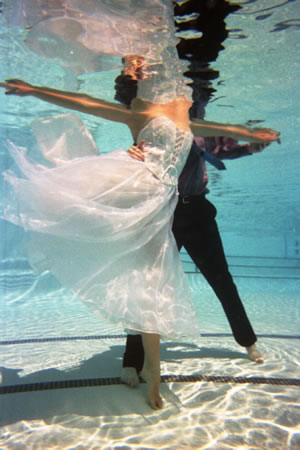
Light and time are encapsulating themes in my work. Underwater photography offers a unique opportunity to distort the appearance of reality through water. This spectacle delves the viewer into suspended gravity and distorted optics. Photography was present throughout my life from an amateur perspective. Before starting college, I participated in a Marine Conservation Project in Thailand, learning ocean conservation and scuba diving. This is where I first got an opportunity to explore underwater photography. While at Pitzer College, this evolved to a more serious compulsion. Nights spent out in nature, I explored ideas concerning the surreal more evident in the dark of night than light of day. Night photography opened the possibility of bending expectations within photography, and through this exploration, surreality in darkness of night lead to an obsession with this phenomenon within underwater photography. My committed participation with the Claremont Colleges Ballroom Dance Company gives me access to another world of fantasy and wonderment. The combination of these themes creates a surreal experience, fusing dance and water into a photographic experience. I use ballroom dancers to exhibit the control and grace of dancing, combined with the surreality of water to create these spectacles. [clear]
Marita Pickron
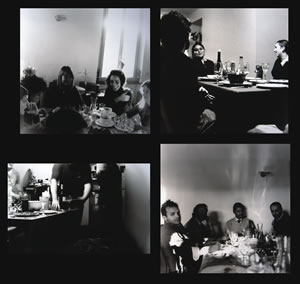
Since elementary school when my mother taught me the very basics of taking a picture with her 35mm SLR, I have become enamored with the process of photographing the world around me. I have always viewed photography as a unique tool enabling me to frame the precise moments, angles and emotions that best capture my understanding and experience of a given instant, rather than simply conveying its physical manifestation. This body of work comprises a series of photographs taken in the past two years while living in the USA, Italy and South Africa. While exploring these distinctly different countries, I was continuously struck by the beauty of socio-cultural particularities in lifestyles, social attitudes and definitions of “norm” that uniquely define daily life in each country. However, I was also very aware from my interactions with passersby and friends that there are some underlying human commonalities—the warmth of sharing a meal with friends and loved ones, music and dance, the desire to explore and learn of the unknown. Although among and even within these countries, the contents of a meal and the definition of family may vary greatly, the underlying actions and motives remain the same. As I explored, listened, and absorbed, I became increasingly aware of common cross-cultural aspirations, experiences and catalysts. I had my camera at the ready and attempted to capture what I perceived as quotidian human experiences in each country—the similar alongside the unique. I hope this collection of jumbled moments and places can inspire the viewer to question their own preconceived notions of “other-ness” as they create for themselves a sense of geographic order in the midst of confusion. [clear]
Kamilla Q. Rifkin
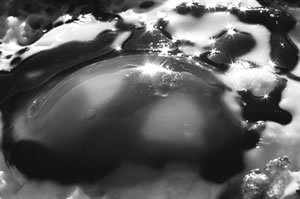
My thesis represents the evolution of food as a theme throughout my work. Food has emerged as a revelatory model for my photography. The elasticity within my subjects—ridged dewy leaves of a red cabbage, gritty millet grains, a brilliantly rubbery albumen of a fried egg—has allowed me to create fantastical landscapes that play with light, shadow, and texture in innovative ways. My work draws inspiration from Edward Weston’s cabbage and bell pepper photos from the 1930s. I am interested in incorporating the practice of dramatizing and eroticizing an inanimate object into my own artwork. From the basic uncooked raw grains on photograms to foods viewed in macro format, I aim to deconstruct the edibles that we are used to seeing on the dinner plate in order to present a new range of images. My goal is to remove each food from immediate recognition, and allow it to reemerge as something more dramatic, massive, abstract. [clear]
Devin von Stade
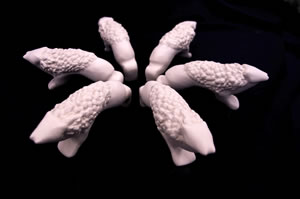
Maine is home. Though I have spent little of the past eight years there, the landscape and its animals have remained a great influenced on my art. Originally a painter idealizing impressionist and surreal works, I spent the past four years working with ceramics. Having previously been hesitant about working in three dimensions, it was a chance to learn anew through play and guidance. Much of my college education was dedicated to the biological sciences with the arts as an outlet for my creativity, and a place to explore my understanding of the natural world. My interest in veterinary medicine, animals and their inherent differences kindles my imagination. I try to create pieces that have a bit of their own life; works that people will want to touch, as well as others that will cause hesitation as if it were an oversized bug. Through this active process, I hope to show a playful development and classification of my ideas, as they have been shaped through my time a Pitzer. Working with clay for the past four years has been inspiring. Given that much of my college education has been dedicated to the sciences, ceramics has allowed me to exercise my creativity. Exploring the development of my ideas, I slip-cast populations of forms and textures influenced by the casting process. Specific aspects that effected how the molds were made were carried through to the next piece I made. With my focused study on anatomy and biomechanics, animals often influence my thought process and guide my work. I try to create pieces that people want to touch, as well as others that might cause hesitation and repulsion, as if it were a live bug, or in the worry that the creature would be skittish. By delving into this obsession, I focused on the string of consciousness that contributes to my artistic process, considering each branch of potential development. Through this living process, I hope to show the playful development and classification of my ideas, as they have been shaped through my time at Pitzer. [clear]
 WORLD IS WATCHING – MANIFESTO
WORLD IS WATCHING – MANIFESTO